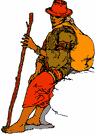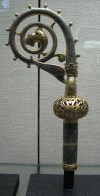Crozier
The crozier is respected as though it's a cross. But it isn't.
Yes, yes, yes, we know; a Crozier has no cross-piece, and therefore shouldn't be in these webpages about crosses.
But neither does the Buttercross in Winchester have a cross, nor countless other market crosses. Kings Cross station in London is another example of the term "cross" being used for something that clearly isn't. And like those, the prelate's crozier is not intended to be a representation of a Christian cross.
Neither is it intended to resemble the crook used by a shepherd (see Shepherd's Cross), even though shepherding is clearly one of the duties of a bishop, as it is with any priest. The difference between a cross and a crozier is that the cross represents the love of God shown through the sacrifice of his Son, Jesus Christ and the crozier is simply a symbol of prelatic authority and jurisdiction.
The crozier may be plain, or feature Agnus Dei, a serpent, or in the case of old Eastern Orthodox croziers, they may appear Tau shaped, like a crutch. Indeed, in the emblems used by many Eastern churches, we see a crozier instead of the cross seen in Western church emblems.
The word crozier can be traced back to the late 13th century from the Latin crociarius, which means "bearer of a cross" and was applied to those who carried the bishop's pastoral staff. In the early 18th century, the term began to be used for the staff itself.

As cross-country hikers know, a walking stick is a useful aid and as we age, it becomes more and more useful. Before we know it, the stick becomes an indispensable companion.
The stick, therefore, is associated with old age, and by extension, with wisdom and respect. Like the military drill-sergeant's baton, it is easy to see why priests of the oldest religions would carry a stick as a mark of their status.
And like many things which became a natural part of Pagan religion, the stick walked its way as a priestly symbol through Judaism into Christianity.
Aaron's rod is one of the better-known examples. The Bible relates how this particular stick was endowed with miraculous power, even when it was not being held by its owner.
Lacrosse
A quick online search for lacrosse sport clubs yields an imaginative array of logos, many of which feature horned demons and dragons, reflecting the aggressive spirit of the warriors who play the sport.
Lacrosse originates from a native-American tribal "game", where teams of hundreds, if not thousands, would battle each other in honour of God and the victorious would claim God's favour.
The passions aroused when playing this game prompted a French Jesuit missionary, Jean de Brébeuf, to introduce the sport to Europeans. This spiritual connection may have influenced him to name the game's apparatus as a crosse, given its similarity with a bishop's crozier.
Newsday's Tom Rock quotes Powless, an Onondaga Chief in his article More Than a Game:
"When we play a game here on Mother Earth, a game is taking place up there in the Land of the Creator at the same time, So then after we pass away and we are through, we have a means by which we can get our stick up into the Creator's world so that we'll play again."
Our time on Earth, whether we play lacrosse or not, is a preparation for the afterlife. Life really is more than a game.
See the meaning of the Cross
See also Bishop's Cross

Armenian Apostolic Orthodox Church

Armenian Orthodox Church of Cilicia

Armenian Patriarchate of Constantinople

Armenian Patriarchate of Jerusalem

Metropolitan Church of Bessarabia
See other pagan symbols used in Christianity
Exod. 4:15-16, 20; 7:10, 17; 8:5, 16-17; 9:23; 10:13; 14:16; 17:9; Num. 17:8-10; 20:11; Ps. 2:9; Ps. 89:32; Isa. 10:24; 11:4; Ezek. 20:37; Heb. 9:4
See, for example, the children's Saint Petersburgh teams named "Devils" and "Dragons", rather than "Saints" hometeamsonline.com/...
More Than a Game, by Tom Rock, Lacrosse Magazine, November/December 2002













